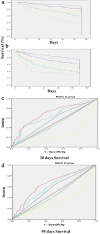Acute kidney injury in hospitalized cirrhotic patients: Risk factors, type of kidney injury, and survival
- PMID: 33553656
- PMCID: PMC7857275
- DOI: 10.1002/jgh3.12467
Acute kidney injury in hospitalized cirrhotic patients: Risk factors, type of kidney injury, and survival
Abstract
Background and aim: Acute kidney injury (AKI) is a common complication of chronic liver disease (CLD). We performed a prospective study to evaluate the risk factors and spectrum of AKI among decompensated cirrhosis (DC) patients and the impact of AKI on survival.
Methods: This study was conducted in consecutive DC patients hospitalized in SCB Medical College between December 2016 and October 2018. AKI was defined as per ICA criteria. Demographic, clinical, and laboratory parameters and outcomes were compared between patients with and without AKI.
Results: A total of 576 DC subjects were enrolled, 315 (54.69%) of whom had AKI; 34% (n = 106) had stage 1A, 28% (n = 90) stage 1B, 21% (n = 65) stage 2, and 17% (n = 54) stage 3 AKI. Alcohol was the predominant cause of CLD (66.7%). In 207 (65.7%) patients, diuretic/lactulose/nonsteroidal anti-inflammatory drugs use was noted, and infection was present in 190 (60.3%) patients. Compared to those without AKI, patients with AKI had higher leucocyte count, higher serum urea and creatinine, higher Child-Turcotte-Pugh, higher Model of End-Stage Liver Disease (MELD) scores (P < 0.001), longer hospital stay, and lower survival at 28 days and 90 days (P < 0.001). Besides, in patients with stages 1A to 3 AKI, there were differences in overall survival at 28 days (P < 0.001) and 90 days (P < 0.001).
Conclusions: Over half of DC patients had AKI, and alcohol was the most common cause of cirrhosis in them. Use of AKI-precipitating medications was the most common cause of AKI, followed by bacterial infection. AKI patients had increased prevalence of acute-on-chronic liver failure and had prolonged hospitalization and lower survival both at 28 days and 90 days.
Keywords: acute kidney injury; acute‐on‐chronic liver failure; chronic liver disease; decompensated cirrhosis.
© 2020 The Authors. JGH Open: An open access journal of gastroenterology and hepatology published by Journal of Gastroenterology and Hepatology Foundation and John Wiley & Sons Australia, Ltd.
Figures

 ), Alcohol; (
), Alcohol; ( ), HBV/HCV infection; (
), HBV/HCV infection; ( ), NASH/NAFLD; (
), NASH/NAFLD; ( ), others. (b) Precipitants of acute kidney injury (AKI) for stages AKI 1A, 1B, 2, and 3. (
), others. (b) Precipitants of acute kidney injury (AKI) for stages AKI 1A, 1B, 2, and 3. ( ), Variceal bleeding; (
), Variceal bleeding; ( ), diarrhoea and/or vomitting; (
), diarrhoea and/or vomitting; ( ), infection; (
), infection; ( ), drug precipitant.
), drug precipitant.
 ) without AKI; (
) without AKI; ( ) AKI 1A; (
) AKI 1A; ( ) AKI 1B; (
) AKI 1B; ( ) AKI 2; (
) AKI 2; ( ) AKI 3. (b) Kaplan–Meier survival curves showed significant differences in survival between patients with acute kidney injury (AKI) 1A, AKI 1B, AKI 2, and AKI 3 and those without acute kidney injury at 90 days (log‐rank P value <0.001). (
) AKI 3. (b) Kaplan–Meier survival curves showed significant differences in survival between patients with acute kidney injury (AKI) 1A, AKI 1B, AKI 2, and AKI 3 and those without acute kidney injury at 90 days (log‐rank P value <0.001). ( ) without AKI; (
) without AKI; ( ) AKI 1A; (
) AKI 1A; ( ) AKI 1B; (
) AKI 1B; ( ) AKI 2; (
) AKI 2; ( ), AKI 3. (c) Receiver operating characteristic curves (AUROC) for prognostic parameters for 28‐day survival in patients with AKI. (
), AKI 3. (c) Receiver operating characteristic curves (AUROC) for prognostic parameters for 28‐day survival in patients with AKI. ( ), Admission serum urea; (
), Admission serum urea; ( ), admission serum creatinine; (
), admission serum creatinine; ( ), infection; (
), infection; ( ), variceal bleeding; (
), variceal bleeding; ( ), diarrhoea/vomiting; (
), diarrhoea/vomiting; ( ), normal creatinine/reversal of AKI; (
), normal creatinine/reversal of AKI; ( ), reference line. (d) Receiver operating characteristic curves (AUROC) for prognostic parameters for 90‐day survival in patients with AKI.
), reference line. (d) Receiver operating characteristic curves (AUROC) for prognostic parameters for 90‐day survival in patients with AKI.References
-
- Schrier RW, Arroyo V, Bernardi M, Epstein M, Henriksen JH, Rodés J. Peripheral arterial vasodilation hypothesis: a proposal for the initiation of renal sodium and water retention in cirrhosis. Hepatology. 1988; 8: 1151–7. - PubMed
-
- Arroyo V, Ginès P, Gerbes AL et al Definition and diagnostic criteria of refractory ascites and hepatorenal syndrome in cirrhosis. International Ascites Club. Hepatology. 1996; 23: 164–76. - PubMed
-
- Martín‐Llahí M, Guevara M, Torre A et al Prognostic importance of the cause of renal failure in patients with cirrhosis. Gastroenterology. 2011; 140: 488–496.e4. - PubMed
-
- Bernardi M, Moreau R, Angeli P, Schnabl B, Arroyo V. Mechanisms of decompensation and organ failure in cirrhosis: from peripheral arterial vasodilation to systemic inflammation hypothesis. J. Hepatol. 2015; 63: 1272–84. - PubMed
-
- Clària J, Stauber RE, Coenraad MJ et al Systemic inflammation in decompensated cirrhosis: characterization and role in acute‐on‐chronic liver failure. Hepatology. 2016; 64: 1249–64. - PubMed
LinkOut - more resources
Full Text Sources
Miscellaneous

